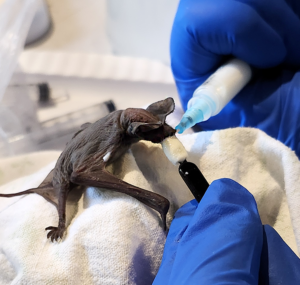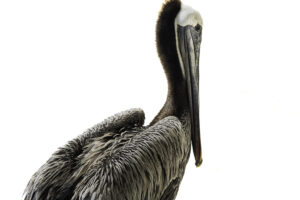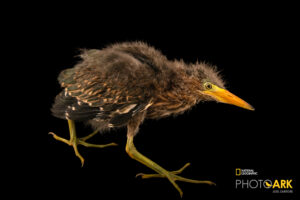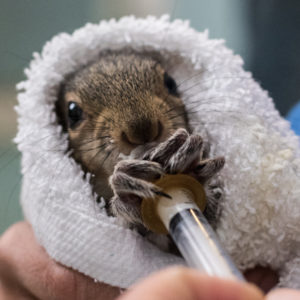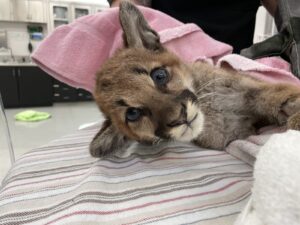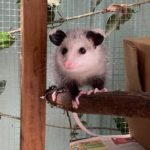 There’s a ghost in my house who only comes out at night – that’s when I can catch a glimpse of his silvery form. For now, this ghost lives in a cage.
There’s a ghost in my house who only comes out at night – that’s when I can catch a glimpse of his silvery form. For now, this ghost lives in a cage.
I’ve only touched him once – when I transferred him at Native Animal Rescue (NAR) into a large plastic dog crate to bring him to my house until he can be safely returned to the wild. Release is always the end goal with NAR, and in the meantime, the intention is to keep the animals as feral as possible. This juvenile male opossum, about five inches long, promptly scurried into the small cardboard box in the very back of the crate, his little face peering out. His black eyes looked more like a pool of water than solid matter.
For the first couple of weeks, he truly seems more ghost than mammal, hiding out in his little cardboard cave, sometimes gathering a hand towel in front so that only his small face is visible: a pink nose, dark eyes and soft ears that look like black and pink flower petals.
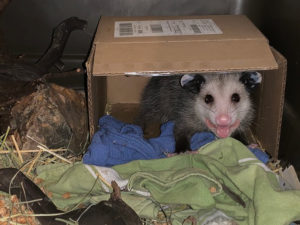 If I put my hand in the cage to deliver food or remove his waste, he shows me his wide opened mouth, tiny teeth exposed, as well as a silent hiss – the actual sound only emerges as he matures and will be a sign he is ready for release.
If I put my hand in the cage to deliver food or remove his waste, he shows me his wide opened mouth, tiny teeth exposed, as well as a silent hiss – the actual sound only emerges as he matures and will be a sign he is ready for release.
Leftovers give clues – I discover that he likes blueberries more than apples, and Brussels sprouts not at all. He likes to poop on the bark covered chunk of wood that I put inside, and sometimes in his water bowl. I learn about him, puzzle piece by puzzle piece, through observation, time, proximity. Some days I only view his rounded back, presumably sleeping, his empty food bowl and two firm turds reassuring me he is still alive. All proof of his nocturnal doings.
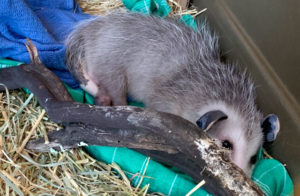 I take it as a sign of growing comfort that he sometimes rests outside of the cave or rolls on his back to sleep, belly exposed, his four legs folded, like a dog asking for a belly rub. But rest assured, he’s not. When he does that, I can see his fascinating feet – four long “fingers” with an opposable thumb, allowing him to grasp tree branches as he makes his way through a forest someday. Unfortunately, he lost a good part of his tail in the attack that brought him to the shelter – a tail that can help with balance, but he should still be able to manage fine. If he had been female, it would have made it harder to collect the materials she needs to make a nest for raising young – the tail able to grasp, carry and arrange twigs and grasses.
I take it as a sign of growing comfort that he sometimes rests outside of the cave or rolls on his back to sleep, belly exposed, his four legs folded, like a dog asking for a belly rub. But rest assured, he’s not. When he does that, I can see his fascinating feet – four long “fingers” with an opposable thumb, allowing him to grasp tree branches as he makes his way through a forest someday. Unfortunately, he lost a good part of his tail in the attack that brought him to the shelter – a tail that can help with balance, but he should still be able to manage fine. If he had been female, it would have made it harder to collect the materials she needs to make a nest for raising young – the tail able to grasp, carry and arrange twigs and grasses.
Typically, opossums most often arrive at Native Animal Rescue in the pouch of a mother who has been killed on the road. One such litter arrives during my shift. I observe as a seasoned worker pulls each tiny, tiny baby off the mother’s long teats. Thirteen babies, without fur, eyes closed. I can’t describe the incredible finesse required to thread the tiniest tube down each of these little throats in order to pump sustenance into their bodies. All done with calm caring certainty. The little opossum that resides in my house probably fell off his mother’s back prematurely and was then attacked by a cat, dog or some other animal – narrowly escaping with half his tail.
So this small phantom grows bigger and bigger. It’s not only because of his elusive nature and his grey form that I began to call him a ghost – it’s because I am haunted. He got inside of me. How did that happen, how did I get so attached to a being that rarely shows himself, for whom I’m a looming presence that he probably hopes won’t notice him, and better yet, will disappear? I think of him through the day, wonder how he is doing, peek around the door to see if I can catch just a glimpse of his face. I feel great tenderness for this mammal that many describe as unsightly, with their prehistoric-like face. Is it his quiet presence? We humans have a tendency to identify with various animals and to project our own feelings and traits onto them. I’m aware that’s part of what is going on: the introvert in me resonates with his reticent, solitary nature and my maternal instincts are certainly activated by his shyness.
And then one evening I watched him transform from a shy ghost into a feral creature, into full possum-ness. My mentors at Native Animal Rescue had sent me home with a sad Ziploc bag of frozen songbirds, those who had not survived despite the expert care they received. I was instructed to place one inside his cage at night. Opossums eat carrion and this is part of his education.
Instinct makes for a quick learner. The instant I placed the bird inside, this previously cautious young opossum rose purposefully from his cave, nose raised, sniffing the air, looking much bigger than I had ever seen him. He exuded presence as he towered over this prize. I sensed his focused intensity as he lowered his head, the “fingers” of his paws stretched wide as they secured the bird’s body. Without hesitation, he began to methodically consume this little being, bones, beak, leathery legs and all. Two small feathers were the only indication of what had transpired. I was transfixed, tenderness morphing into awe and a tinge of admiring horror. The feral had merely lain dormant, waiting to manifest. I no longer worried how he might manage upon release. He knows what he does not yet know. Now I know that as well.
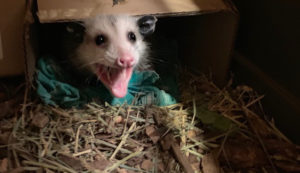 When I made use of this useful link to clean his cage today, he not only stretched his mouth open wide but I heard a growly hiss as he lunged – more a defensive tactic than an intended attack – but I quickly withdrew having received the message. I realize that he has matured enough to be released soon. I imagine I’ll feel a literal “empty nest syndrome,” missing this elusive resident, but like a human parent, this is a launching endeavor, success defined by preparation for the risks inherent in life.
When I made use of this useful link to clean his cage today, he not only stretched his mouth open wide but I heard a growly hiss as he lunged – more a defensive tactic than an intended attack – but I quickly withdrew having received the message. I realize that he has matured enough to be released soon. I imagine I’ll feel a literal “empty nest syndrome,” missing this elusive resident, but like a human parent, this is a launching endeavor, success defined by preparation for the risks inherent in life.
This juncture brings up one of the most important considerations – how to release him. Initially, I had assumed I could do it near my home, given the wild chaparral that borders my land and the wide array of animals that pass through. But I think of the neighbor dogs and that there is no close permanent water source. While it’s appealing to think of him living nearby, I need to do better than that.
I contact the “Opossum Lady,” the woman who fosters and releases numerous opossums for Native Animal Rescue, as well as providing workshops and manuals for volunteers. She agrees that he sounds ready. I bring him to her home where we transfer him to a large outdoor cage specifically designed for opossums where they can acclimate to the outdoors, hunt worms and crickets placed inside the run as they build their muscles through climbing the large branches placed inside. After a transitional period, he will be released far from roads and human encroachment. This well-devised plan gives me comfort.
As I drive home, I imagine sometime catching a glimpse of another silvery phantom crossing the road in the night (phew! safely) or ambling along a fence railing and how I will then remember this particular opossum, picturing his human-like feet, the texture of his silver and dark grey coat, the liquid quality of his eyes. I will hope that this half-tailed creature is thriving, still warding off danger with his hissing, wide-opened mouth, still devouring carrion, still soundly sleeping in a safe, hollowed-out den.
Marilyn DuHamel is a psychotherapist and writer who lives in Ben Lomond. She regularly posts essays on her blog, Earth Dialogues, at www.marilynduhamel.com. Her intention is to help people care more deeply about the natural world, believing that what we love we will not turn away from.

